Strategic Management Report: Tesla's Competitive Advantage
VerifiedAdded on 2022/09/09
|6
|1339
|17
Report
AI Summary
This report provides a comprehensive strategic management analysis of Tesla Motors, a leading electric vehicle manufacturer. The report begins with an overview of Tesla's operations, including its main products, market position, and financial performance. It then delves into an evaluation of Tesla's performance, utilizing SWOT analysis and Porter's Five Forces to identify opportunities, threats, strengths, and weaknesses. The report examines the criteria and tools used to assess Tesla's performance in the global market, highlighting its loyal customer base and high-quality products. It also discusses the control mechanisms employed by Tesla, such as the use of solar energy in battery production, and how the company manages environmental risks. Furthermore, the report analyzes Tesla's competitive advantages, focusing on its strategies for market penetration and product development. It concludes with recommendations for Tesla's managers to enhance its competitive advantage, emphasizing the importance of innovation, research, and development. The report also addresses the compatibility of creativity and control in a business environment, and discusses the impact of corporate culture and organizational structures on strategic management.
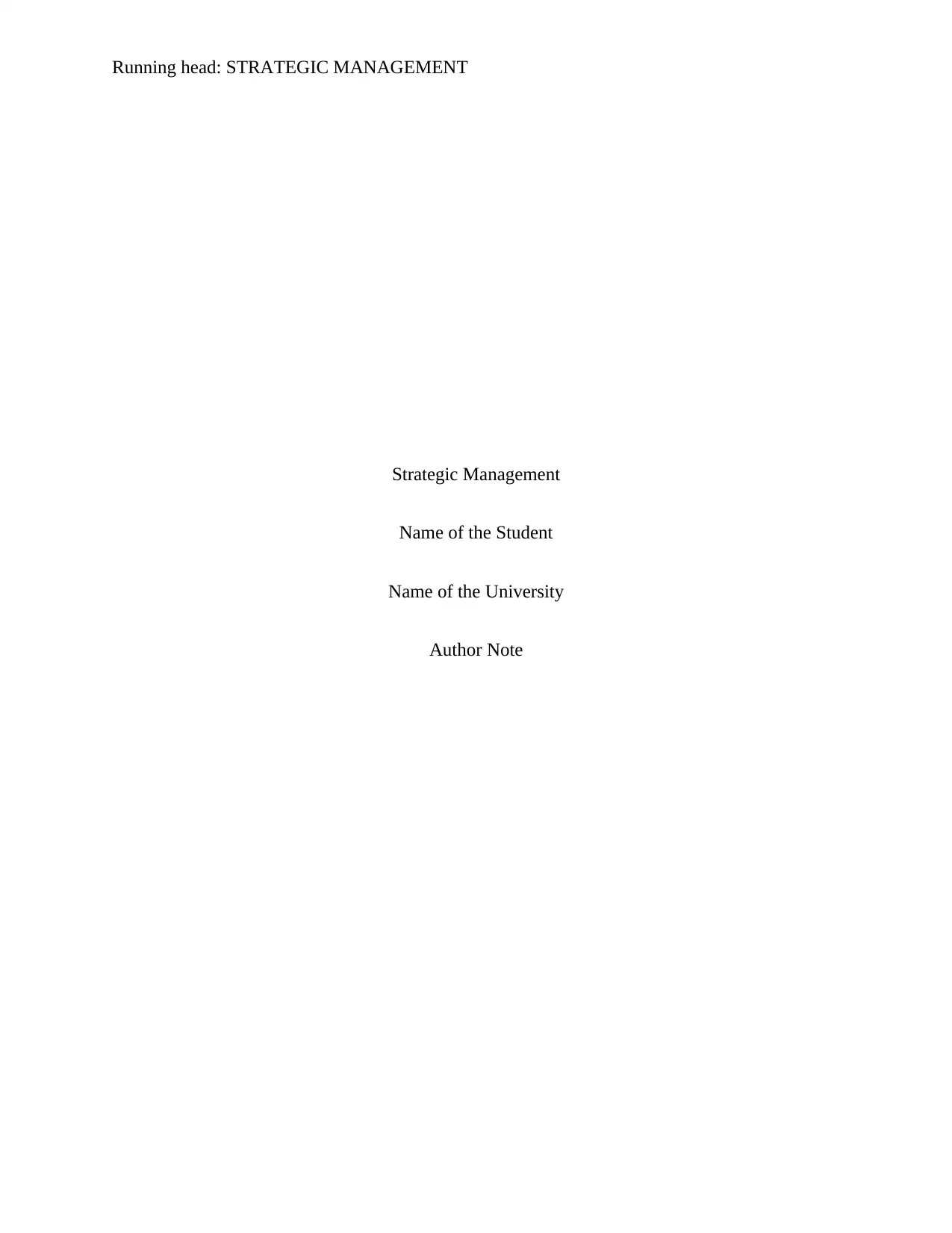
Running head: STRATEGIC MANAGEMENT
Strategic Management
Name of the Student
Name of the University
Author Note
Strategic Management
Name of the Student
Name of the University
Author Note
Paraphrase This Document
Need a fresh take? Get an instant paraphrase of this document with our AI Paraphraser
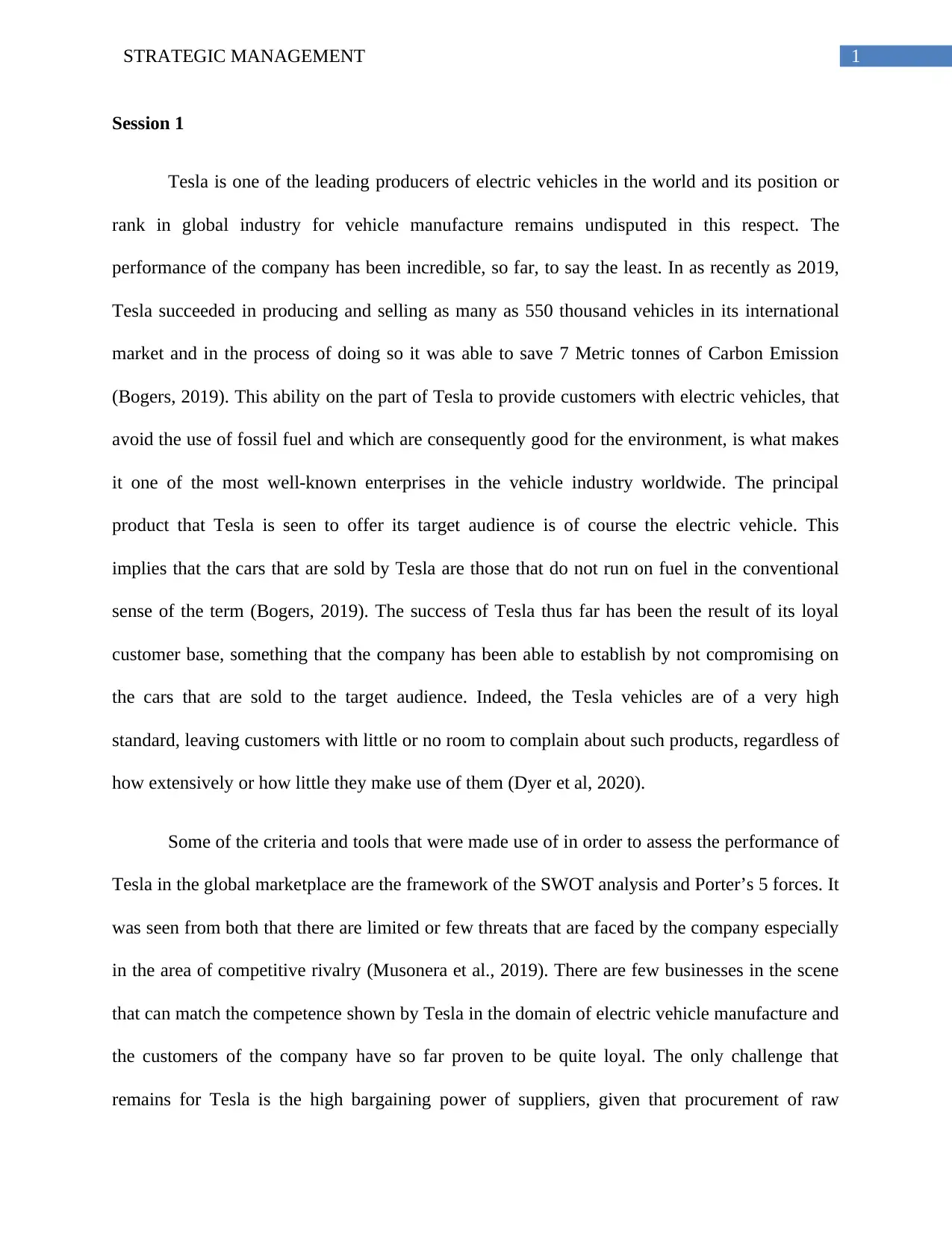
1STRATEGIC MANAGEMENT
Session 1
Tesla is one of the leading producers of electric vehicles in the world and its position or
rank in global industry for vehicle manufacture remains undisputed in this respect. The
performance of the company has been incredible, so far, to say the least. In as recently as 2019,
Tesla succeeded in producing and selling as many as 550 thousand vehicles in its international
market and in the process of doing so it was able to save 7 Metric tonnes of Carbon Emission
(Bogers, 2019). This ability on the part of Tesla to provide customers with electric vehicles, that
avoid the use of fossil fuel and which are consequently good for the environment, is what makes
it one of the most well-known enterprises in the vehicle industry worldwide. The principal
product that Tesla is seen to offer its target audience is of course the electric vehicle. This
implies that the cars that are sold by Tesla are those that do not run on fuel in the conventional
sense of the term (Bogers, 2019). The success of Tesla thus far has been the result of its loyal
customer base, something that the company has been able to establish by not compromising on
the cars that are sold to the target audience. Indeed, the Tesla vehicles are of a very high
standard, leaving customers with little or no room to complain about such products, regardless of
how extensively or how little they make use of them (Dyer et al, 2020).
Some of the criteria and tools that were made use of in order to assess the performance of
Tesla in the global marketplace are the framework of the SWOT analysis and Porter’s 5 forces. It
was seen from both that there are limited or few threats that are faced by the company especially
in the area of competitive rivalry (Musonera et al., 2019). There are few businesses in the scene
that can match the competence shown by Tesla in the domain of electric vehicle manufacture and
the customers of the company have so far proven to be quite loyal. The only challenge that
remains for Tesla is the high bargaining power of suppliers, given that procurement of raw
Session 1
Tesla is one of the leading producers of electric vehicles in the world and its position or
rank in global industry for vehicle manufacture remains undisputed in this respect. The
performance of the company has been incredible, so far, to say the least. In as recently as 2019,
Tesla succeeded in producing and selling as many as 550 thousand vehicles in its international
market and in the process of doing so it was able to save 7 Metric tonnes of Carbon Emission
(Bogers, 2019). This ability on the part of Tesla to provide customers with electric vehicles, that
avoid the use of fossil fuel and which are consequently good for the environment, is what makes
it one of the most well-known enterprises in the vehicle industry worldwide. The principal
product that Tesla is seen to offer its target audience is of course the electric vehicle. This
implies that the cars that are sold by Tesla are those that do not run on fuel in the conventional
sense of the term (Bogers, 2019). The success of Tesla thus far has been the result of its loyal
customer base, something that the company has been able to establish by not compromising on
the cars that are sold to the target audience. Indeed, the Tesla vehicles are of a very high
standard, leaving customers with little or no room to complain about such products, regardless of
how extensively or how little they make use of them (Dyer et al, 2020).
Some of the criteria and tools that were made use of in order to assess the performance of
Tesla in the global marketplace are the framework of the SWOT analysis and Porter’s 5 forces. It
was seen from both that there are limited or few threats that are faced by the company especially
in the area of competitive rivalry (Musonera et al., 2019). There are few businesses in the scene
that can match the competence shown by Tesla in the domain of electric vehicle manufacture and
the customers of the company have so far proven to be quite loyal. The only challenge that
remains for Tesla is the high bargaining power of suppliers, given that procurement of raw
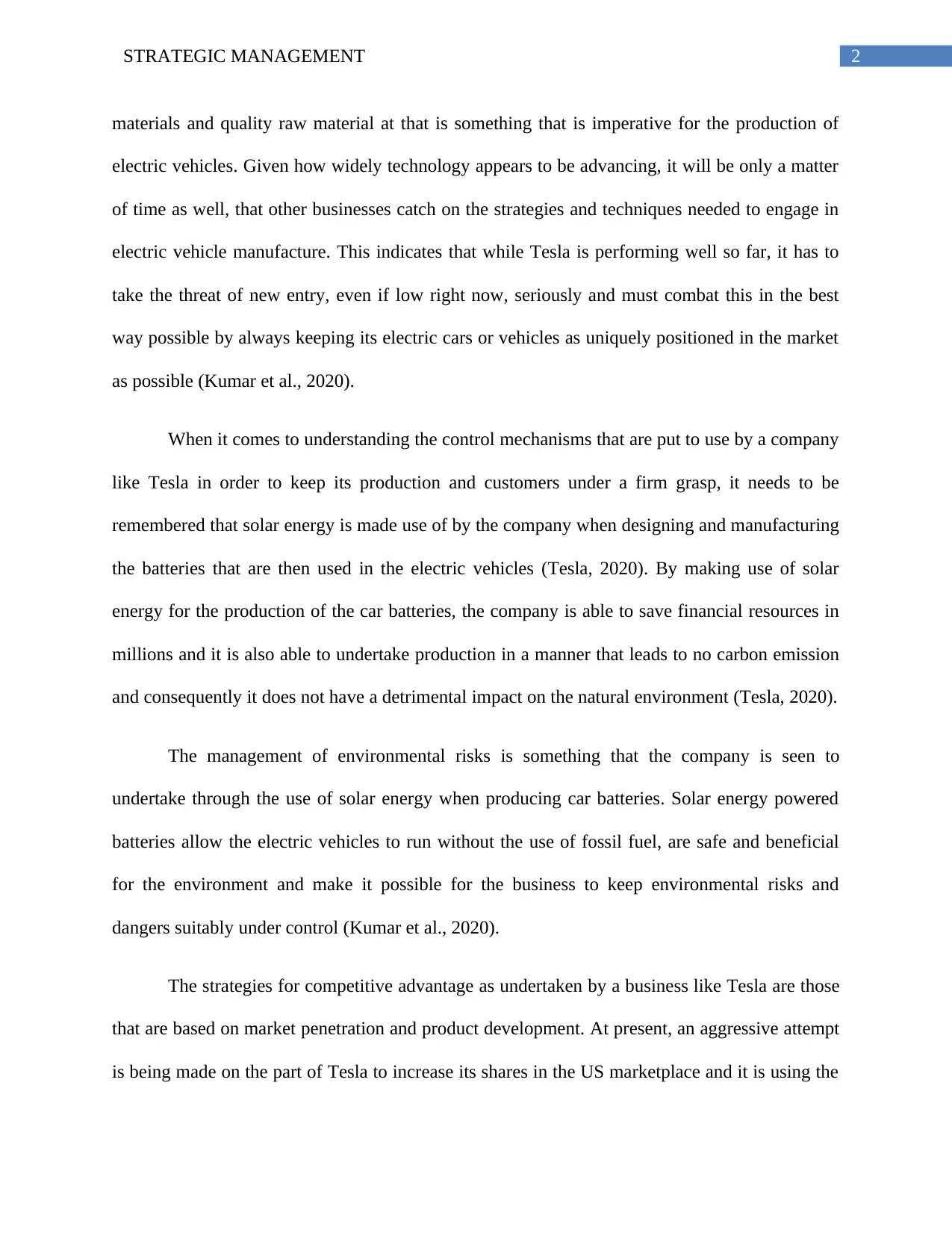
2STRATEGIC MANAGEMENT
materials and quality raw material at that is something that is imperative for the production of
electric vehicles. Given how widely technology appears to be advancing, it will be only a matter
of time as well, that other businesses catch on the strategies and techniques needed to engage in
electric vehicle manufacture. This indicates that while Tesla is performing well so far, it has to
take the threat of new entry, even if low right now, seriously and must combat this in the best
way possible by always keeping its electric cars or vehicles as uniquely positioned in the market
as possible (Kumar et al., 2020).
When it comes to understanding the control mechanisms that are put to use by a company
like Tesla in order to keep its production and customers under a firm grasp, it needs to be
remembered that solar energy is made use of by the company when designing and manufacturing
the batteries that are then used in the electric vehicles (Tesla, 2020). By making use of solar
energy for the production of the car batteries, the company is able to save financial resources in
millions and it is also able to undertake production in a manner that leads to no carbon emission
and consequently it does not have a detrimental impact on the natural environment (Tesla, 2020).
The management of environmental risks is something that the company is seen to
undertake through the use of solar energy when producing car batteries. Solar energy powered
batteries allow the electric vehicles to run without the use of fossil fuel, are safe and beneficial
for the environment and make it possible for the business to keep environmental risks and
dangers suitably under control (Kumar et al., 2020).
The strategies for competitive advantage as undertaken by a business like Tesla are those
that are based on market penetration and product development. At present, an aggressive attempt
is being made on the part of Tesla to increase its shares in the US marketplace and it is using the
materials and quality raw material at that is something that is imperative for the production of
electric vehicles. Given how widely technology appears to be advancing, it will be only a matter
of time as well, that other businesses catch on the strategies and techniques needed to engage in
electric vehicle manufacture. This indicates that while Tesla is performing well so far, it has to
take the threat of new entry, even if low right now, seriously and must combat this in the best
way possible by always keeping its electric cars or vehicles as uniquely positioned in the market
as possible (Kumar et al., 2020).
When it comes to understanding the control mechanisms that are put to use by a company
like Tesla in order to keep its production and customers under a firm grasp, it needs to be
remembered that solar energy is made use of by the company when designing and manufacturing
the batteries that are then used in the electric vehicles (Tesla, 2020). By making use of solar
energy for the production of the car batteries, the company is able to save financial resources in
millions and it is also able to undertake production in a manner that leads to no carbon emission
and consequently it does not have a detrimental impact on the natural environment (Tesla, 2020).
The management of environmental risks is something that the company is seen to
undertake through the use of solar energy when producing car batteries. Solar energy powered
batteries allow the electric vehicles to run without the use of fossil fuel, are safe and beneficial
for the environment and make it possible for the business to keep environmental risks and
dangers suitably under control (Kumar et al., 2020).
The strategies for competitive advantage as undertaken by a business like Tesla are those
that are based on market penetration and product development. At present, an aggressive attempt
is being made on the part of Tesla to increase its shares in the US marketplace and it is using the
⊘ This is a preview!⊘
Do you want full access?
Subscribe today to unlock all pages.

Trusted by 1+ million students worldwide
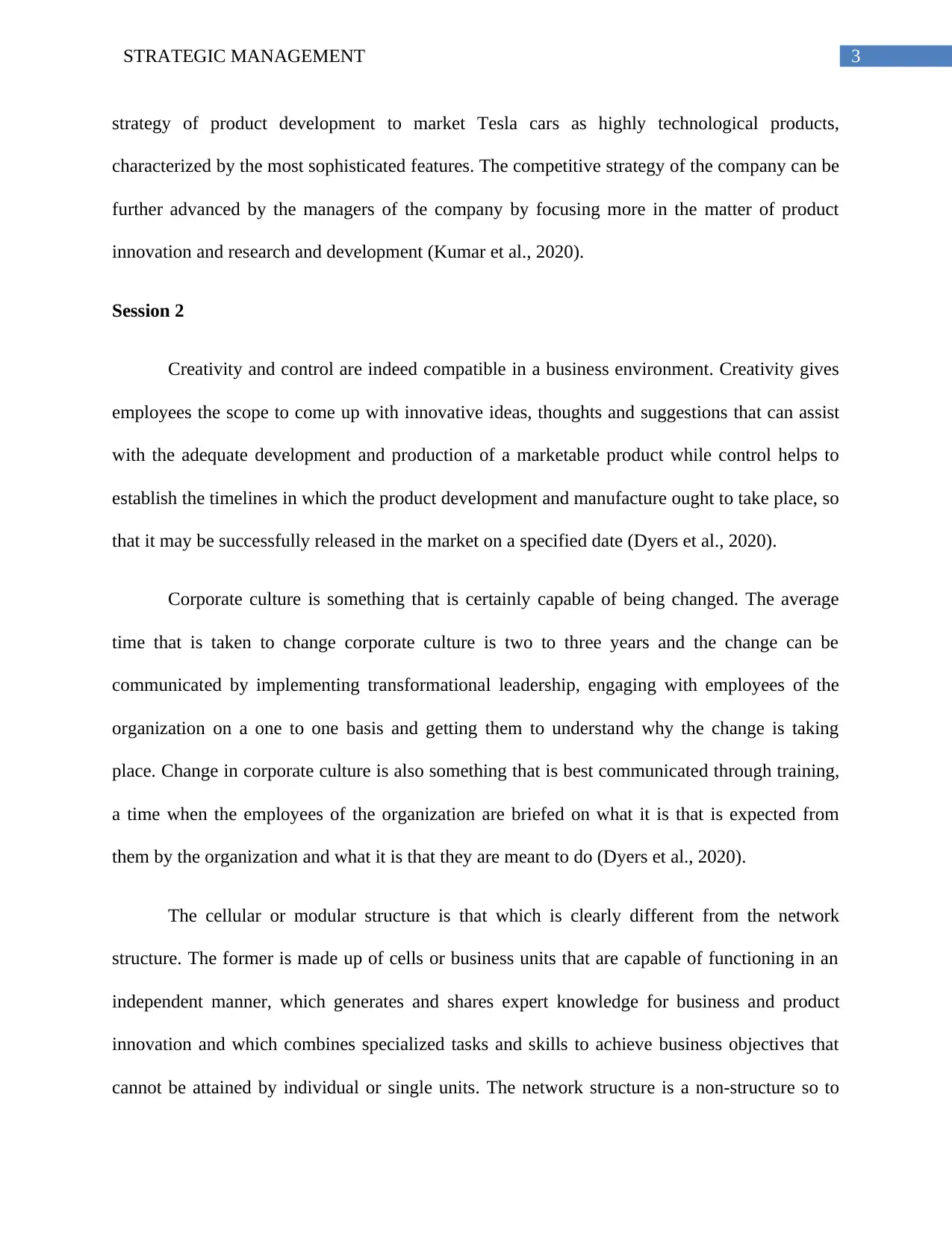
3STRATEGIC MANAGEMENT
strategy of product development to market Tesla cars as highly technological products,
characterized by the most sophisticated features. The competitive strategy of the company can be
further advanced by the managers of the company by focusing more in the matter of product
innovation and research and development (Kumar et al., 2020).
Session 2
Creativity and control are indeed compatible in a business environment. Creativity gives
employees the scope to come up with innovative ideas, thoughts and suggestions that can assist
with the adequate development and production of a marketable product while control helps to
establish the timelines in which the product development and manufacture ought to take place, so
that it may be successfully released in the market on a specified date (Dyers et al., 2020).
Corporate culture is something that is certainly capable of being changed. The average
time that is taken to change corporate culture is two to three years and the change can be
communicated by implementing transformational leadership, engaging with employees of the
organization on a one to one basis and getting them to understand why the change is taking
place. Change in corporate culture is also something that is best communicated through training,
a time when the employees of the organization are briefed on what it is that is expected from
them by the organization and what it is that they are meant to do (Dyers et al., 2020).
The cellular or modular structure is that which is clearly different from the network
structure. The former is made up of cells or business units that are capable of functioning in an
independent manner, which generates and shares expert knowledge for business and product
innovation and which combines specialized tasks and skills to achieve business objectives that
cannot be attained by individual or single units. The network structure is a non-structure so to
strategy of product development to market Tesla cars as highly technological products,
characterized by the most sophisticated features. The competitive strategy of the company can be
further advanced by the managers of the company by focusing more in the matter of product
innovation and research and development (Kumar et al., 2020).
Session 2
Creativity and control are indeed compatible in a business environment. Creativity gives
employees the scope to come up with innovative ideas, thoughts and suggestions that can assist
with the adequate development and production of a marketable product while control helps to
establish the timelines in which the product development and manufacture ought to take place, so
that it may be successfully released in the market on a specified date (Dyers et al., 2020).
Corporate culture is something that is certainly capable of being changed. The average
time that is taken to change corporate culture is two to three years and the change can be
communicated by implementing transformational leadership, engaging with employees of the
organization on a one to one basis and getting them to understand why the change is taking
place. Change in corporate culture is also something that is best communicated through training,
a time when the employees of the organization are briefed on what it is that is expected from
them by the organization and what it is that they are meant to do (Dyers et al., 2020).
The cellular or modular structure is that which is clearly different from the network
structure. The former is made up of cells or business units that are capable of functioning in an
independent manner, which generates and shares expert knowledge for business and product
innovation and which combines specialized tasks and skills to achieve business objectives that
cannot be attained by individual or single units. The network structure is a non-structure so to
Paraphrase This Document
Need a fresh take? Get an instant paraphrase of this document with our AI Paraphraser
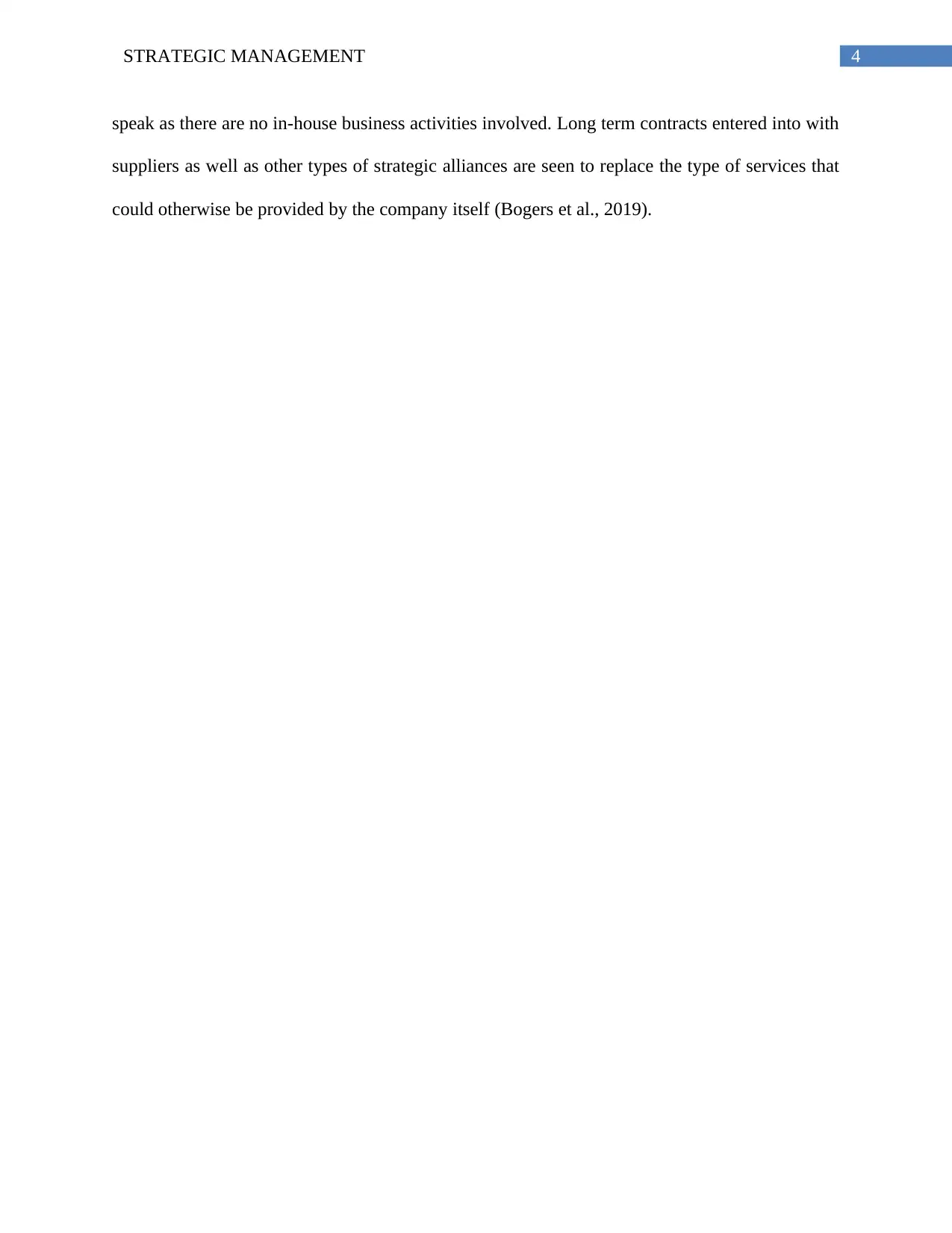
4STRATEGIC MANAGEMENT
speak as there are no in-house business activities involved. Long term contracts entered into with
suppliers as well as other types of strategic alliances are seen to replace the type of services that
could otherwise be provided by the company itself (Bogers et al., 2019).
speak as there are no in-house business activities involved. Long term contracts entered into with
suppliers as well as other types of strategic alliances are seen to replace the type of services that
could otherwise be provided by the company itself (Bogers et al., 2019).
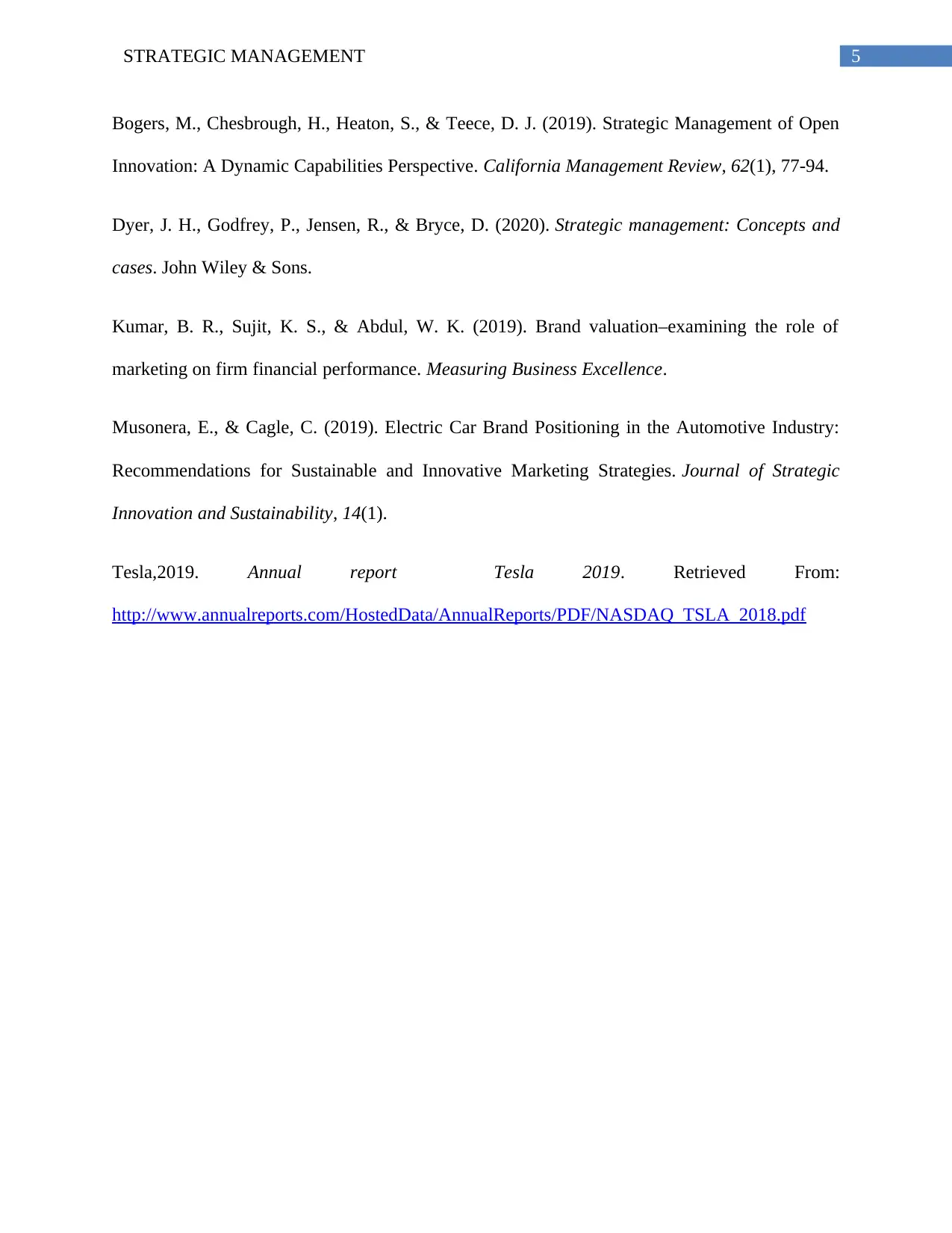
5STRATEGIC MANAGEMENT
Bogers, M., Chesbrough, H., Heaton, S., & Teece, D. J. (2019). Strategic Management of Open
Innovation: A Dynamic Capabilities Perspective. California Management Review, 62(1), 77-94.
Dyer, J. H., Godfrey, P., Jensen, R., & Bryce, D. (2020). Strategic management: Concepts and
cases. John Wiley & Sons.
Kumar, B. R., Sujit, K. S., & Abdul, W. K. (2019). Brand valuation–examining the role of
marketing on firm financial performance. Measuring Business Excellence.
Musonera, E., & Cagle, C. (2019). Electric Car Brand Positioning in the Automotive Industry:
Recommendations for Sustainable and Innovative Marketing Strategies. Journal of Strategic
Innovation and Sustainability, 14(1).
Tesla,2019. Annual report Tesla 2019. Retrieved From:
http://www.annualreports.com/HostedData/AnnualReports/PDF/NASDAQ_TSLA_2018.pdf
Bogers, M., Chesbrough, H., Heaton, S., & Teece, D. J. (2019). Strategic Management of Open
Innovation: A Dynamic Capabilities Perspective. California Management Review, 62(1), 77-94.
Dyer, J. H., Godfrey, P., Jensen, R., & Bryce, D. (2020). Strategic management: Concepts and
cases. John Wiley & Sons.
Kumar, B. R., Sujit, K. S., & Abdul, W. K. (2019). Brand valuation–examining the role of
marketing on firm financial performance. Measuring Business Excellence.
Musonera, E., & Cagle, C. (2019). Electric Car Brand Positioning in the Automotive Industry:
Recommendations for Sustainable and Innovative Marketing Strategies. Journal of Strategic
Innovation and Sustainability, 14(1).
Tesla,2019. Annual report Tesla 2019. Retrieved From:
http://www.annualreports.com/HostedData/AnnualReports/PDF/NASDAQ_TSLA_2018.pdf
⊘ This is a preview!⊘
Do you want full access?
Subscribe today to unlock all pages.

Trusted by 1+ million students worldwide
1 out of 6
Related Documents
Your All-in-One AI-Powered Toolkit for Academic Success.
+13062052269
info@desklib.com
Available 24*7 on WhatsApp / Email
![[object Object]](/_next/static/media/star-bottom.7253800d.svg)
Unlock your academic potential
Copyright © 2020–2025 A2Z Services. All Rights Reserved. Developed and managed by ZUCOL.





